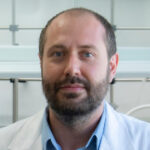
Albert Comelli, PhD
Group coordinator
acomelli@fondazionerimed.com
Contatti:
Via FIlippo Marini, 1490100, Palermo, Italia
acomelli@fondazionerimed.com
Sedi Ri.MED Lab:
c/o Laboratori UNIPA – Via Marini, PA
c/o Istituto Zooprofilattico, PA
c/o IRCCS ISMETT, PA
Facilities:
Collaborazioni:
• IRCCS ISMETT, Palermo, Italy
• Institute of Molecular Bioimaging and
Physiology, National Research Council
(IBFM-CNR), Cefalù, Italy
• University of Palermo, Palermo, Italy
• University of Catania, Catania, Italy
• University of Messina, Messina, Italy
• Biomedical campus university of Rome,
Rome, Italy
• Cannizzaro Hospital, Catania, Italy
• University Hospital, Palermo, Italy
• Istituto Zooprofilattico Sicilia (IZS),
Palermo, Italy
Description
The Imaging and Radiomics research group uses a synergistic combination of Artificial Intelligence, Radiomics, Biotechnology and Image Processing techniques to solve new emerging experimental challenges in the field of Biomedical Imaging and Radiobiology, areas that require the ever closer collaboration of figures professionals with different backgrounds, such as Computer Scientists, Biotechnologists, differently specialized Medical Doctors, Engineers and Clinicians from all sectors.
Our multidisciplinary team is composed of scientific figures who have Transversal skills suitable to support the entire translational workflow ranging from the processing In-Vitro tests (cell models) to Ex-Vivo tests (phantom, scaffold, tissues and organs) and In -Vivo (animal models), up to the Analysis through Artificial Intelligence, Machine Learning and Deep Learning algorithms applied to Multispectral Images in the Agri-food field and Biomedical Images (Cellular, Preclinical and Clinical).
Aim
- To develop Artificial Intelligence systems to support Biomedical decision-making
- To develop tools for target Detection, Segmentation and Classification in biomedical Imaging
- To develop Radiomics tools for Preclinical Biodistribution analysis of Radiopharmaceuticals
- In Vitro Quantification of Radioactive compounds
Focus
- Artificial Intelligence in Precision Medicine
- Radiomics for the quantitative evaluation of the Efficacy of treatments
- In Vitro and In Vivo Theranostic studies: New Radiopharmaceuticals for Diagnosis and Therapy
- Radiobiology Studies for Dosimetry-Time Effectiveness of Radiopharmaceutical Therapy
Expertise and resources
- Imaging, Radiomics, Artificial Intelligence, Deep Learning, Machine Learning
- Biodistribution analysis of Radiopharmaceuticals: Preclinical Molecular Imaging
- In Vitro and In Vivo Radiobiology: Radiopharmaceuticals and Radio-labeled Chelators
- PET/CT, MRI, HRCT, IVIS, Gamma Counter
- Python, Matlab, CUDA
Activities carried out and areas of application
Radiobiology and Innovative Theranostic Radiopharmaceuticals:
- Design and set up of In-Vitro models for the study of Radiobiology using cellular models and Radiometric counters;
- From the evaluation of New Radiopharmaceuticals directly on Cellular models in the Inflammatory and Oncological field (Radiobiology In-Vitro test, using gamma counter) to the analysis of Biodistribution Radiomics of New Radiotracers suitable for PET/SPECT through Non-Invasive Imaging on Animal models (In-Vivo test) in the field of Theranostics (Diagnosis and Therapy) Radiobiology;
- Dose-uptake studies, internalization/externalization of Bioactive and Radiolabeled compounds as a concentration-time curve, competition tests with specific inhibitors, temporal trends of externalization through dosimetric quantifications of the release of Bioactive and Radiolabeled compounds, Viability assays for Radiometric quantification uptake;
- Applications of Artificial Intelligence, Nuclear Medicine therapy, and PET/MRI
Biodiversity and Precision Medicine:
- From the In-Vitro and In-Vivo evaluation of Polyphenols and natural substances on Cellular and animal models through Preclinical Imaging (High Resolution CT, MRI, IVIS) for Therapeutic applications in the Biomedical field
Big Data Analysis in the Agri-food sector:
- Artificial Intelligence applied to thermal and RGB images for monitoring and sustainable management in the agri-food sector
Anatomical Pathology and Artificial Intelligence:
- Evaluation of the Expression of Molecular Features involved in the regulation of the Immune response against Cancer through Digital Analysis of Histopathological and Histochemical Diagnostic Images, through Machine Learning, Pattern Recognition and Decision Support System techniques
Artificial Intelligence and Radiomics Tool development:
- Implementation of Artificial Intelligence algorithms (Deep and Machine Learning), semiautomatic filters and Radiomics for Image analysis, for Cell counting, for Biodistribution studies, for the identification and quantification of In-Vitro, Preclinical and Clinic Region Of Interests;
- Development of models for Detection, Segmentation and Classification of targets in Biomedical Imaging and 3D morphological reconstruction of Regions of Interest (ROI) for bioprinting (e.g. prototyping of anthropomorphic 3D scaffolds that simulate tissues, lesions, etc.) supported by a Machine Learning approach;
- Segmentation and Analysis of Preclinical and Clinical 3D images (MRI/ CT/PET/SPECT/IVIS) and 2D images (histological and microscopy) to extract new Radiomic Biomarkers through correlation through different imaging methods;
- Support medical/biomedical system decisions and identification of new bio-markers through the extraction and specific selection of Radiomic features, to correlate them with other Omics and other Artificial Intelligence systems training (machine learning and deep learning) that allow to determine the early efficacy treatment in both the preclinical and clinical model;
- Morphological and Bioluminescence Imaging acquisition and analysis by microCT/IVIS/MRI Imaging using 2.5 and 3D scaffolds under cell culture conditions (static and/or dynamic), and analysis using Artificial Intelligence and Radiomics algorithms;
- Analysis and Processing of Biomedical images in the neurological field, statistical analysis of physiological signals;
- Development of techniques for independent components analysis of the Human Brain in Functional Magnetic Resonance domain-related information;
- Anatomical areas treated: liver, lungs, breast, prostate, pancreas, brain, head, neck, heart, cardiovascular, musculoskeletal and colorectal;
- Software development of new algorithms, mainly written in C, C ++, Matlab or Python.
Team
